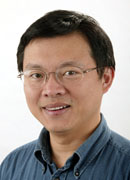Samueli School Engineers Developing Novel Nano Methods to Control Droplet Sizes Utilizing Microfluidic Platforms
Professor Lee and his research team focus on advanced technology, which permits exact amounts of biomolecules, drugs and reagents for encapsulation
 Droplets and bubbles can virtually be found almost everywhere in daily living, and Abraham Lee, Ph.D., a professor in the Department of Biomedical Engineering and Mechanical and Aerospace Engineering, works diligently at the Integrated Nanosystems Research Facility to accurately control the size of droplets and particles - diameters that range from 10nm to 100μm - while also managing the encapsulation of desired amounts of drugs, reagents and biomolecules by utilizing microfluidic platforms.
Droplets and bubbles can virtually be found almost everywhere in daily living, and Abraham Lee, Ph.D., a professor in the Department of Biomedical Engineering and Mechanical and Aerospace Engineering, works diligently at the Integrated Nanosystems Research Facility to accurately control the size of droplets and particles - diameters that range from 10nm to 100μm - while also managing the encapsulation of desired amounts of drugs, reagents and biomolecules by utilizing microfluidic platforms.
The essential component of droplet commercial functions is the size control and material content directly related to its desired application. In most conventional methods to manufacture droplets and particles, the sizes are not uniform. Further, it is difficult to have precise concentrations of reagents encapsulated within the droplet make-up.
Through Lee’s research, droplets are generated using a unique shear focusing design, along with other channel geometry, and specific flow control techniques enable the further manipulation of the droplet mixing, fusion, fission and sorting. Rapid mixing of reagents and samples within the microfluidic droplets dramatically accelerate the hybridization of molecular probes and shorten the incubation time for target binding.
The controlled fusion of droplets in microchannels allows the manufacturing of monodispersed micro and nano particles with synthesis reactions that are not normally possible. Further, chemistry can be performed within these droplets because there is no need to utilize surfactants, a required method in most conventional industry processing. Lee is currently developing an integrated microfluidic platform, a more permanent, yet portable instrument with the control electronics and disposable microfluidic chips, which are inserted into the instrument and then discarded.